Hypo Tirol – Repeat after me: HTTP is bad, HTTPS is good
January 24, 2015
As I know many friends which are Hypo Tirol banking customers and are using the mobile banking app – and my wife is on a business trip and its dark outside – I took a short look at the mobile banking app for Android. And “Oh my God” the same mistakes banks made 10 years ago with online banking are made again.
I downloaded the app and launched it … I got to following
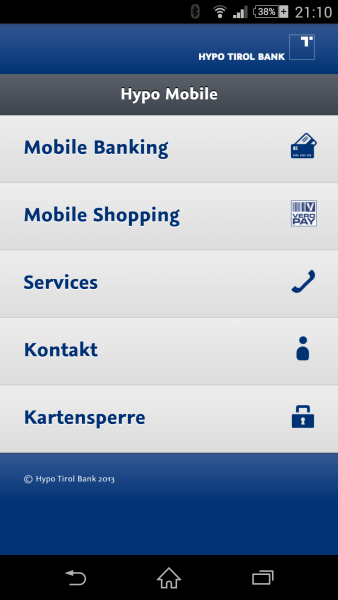
So what does Wireshark tell me after the I started the app?
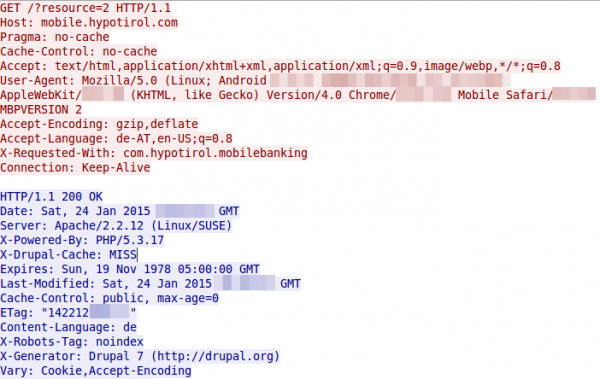
Yes, there is some (most part) HTTP … so lets open the URL on my PC.
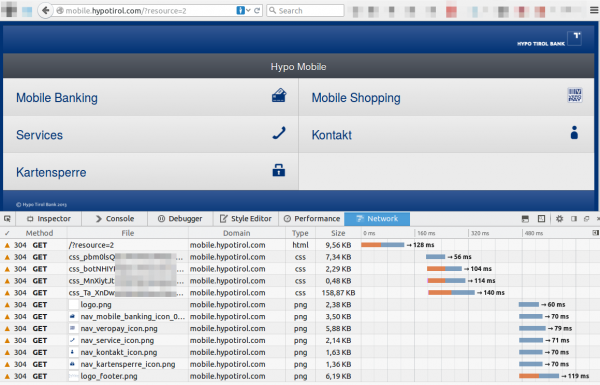
so the whole starting GUI of the banking app is transferred from the server via HTTP.
Attack vector
An attacker can use this to change the content to his liking and as the URL is not shown in the app it could be anything. An idea would be a site that looks like the banking site. The link “Mobile Banking” goes to the HTTPS URL
https://mbp.banking.co.at/appl/mbp/login.html?resource=002
The attacker just can copy and paste the pages and change the links, so it looks identical for the user ;-). So the only question remains – how an attacker can change the content:
- The DNS servers return the IP address of the attacker for mobile.hypotirol.com
- there are many know worms that change the DNS server settings of consumer internet routers
- DNS poisoning attacks … seen in the wild for banking attacks
- A Man in the Middle attack on a public Wifi, but the first two are much easier and can be exploited remotely.
Fix
Use HTTPS everywhere – no HTTP. And check the certificates.
Dropbox notify feature leaks information
January 20, 2015
While I was routinly looking with Wireshark through traffic … everybody needs a hobby 😉 … I saw something interesting. One client was sending a HTTP GET request every 55 seconds. Looking at that request showed following:

which leads to following response normally:
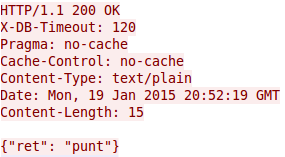
But lets take a look back to the request. This is the Dropbox client doing requests for checking if some other host changed a file. The problem is that it is HTTP and not HTTPS and the user_id and host_int is send in clear text as GET parameters. With this it is easy for some party that sees much of the traffic to track a user over networks and devices. Ok that can also be done via cookies as the Snowden documents show, but they are not send every 55 seconds even if you don’t surf the web – the client does that in the background all the time – a wonderful tracking beacon.
I find that a bad security practice as with HTTPS there would be no information leak and as the SSL connection could also be persistent as the HTTP connection already is, it would be no big additional load on the servers. Anyway – even if HTTP would be a must, it should be POST and not GET, as the GET parameters are stored in proxies servers (e.g. in a transparent ones)
Do not rely on Windows DHCP server logs as security logs
January 18, 2015
Many companies I know backup their DHCP log files so that they are able to but a MAC address to an IP address seen in an security incident. Sure it is possible that an attacker uses a static IP address, but more often than not is a dynamic one – just because it is easier or he does not posses the privileges to change it. Even if you’re using a simple MAC address based network authentication solution you’ll have log files which ties the MAC address to a specific Ethernet port and so a physical location.
So far so good, but there is a problem with this setup and the Windows DHCP server (at least in 2008R2 and newer) – I didn’t check other server. Lets take a look at the log file and how it looks normally.
Microsoft DHCP Service Activity Log
Event ID Meaning
...
10 A new IP address was leased to a client.
11 A lease was renewed by a client.
...
ID,Date,Time,Description,IP Address,Host Name,MAC Address,User Name, TransactionID, QResult,Probationtime, CorrelationID,Dhcid.
11,01/16/15,00:00:15,Renew,10.xxx.xxx.xxx,coolhostname.domain,940C6D4B992E,,373417312,0,,,
So we’ve a renew here and we’re able to tie the IP address to the MAC address. But sometimes you’ll see entries like this:
11,01/18/15,09:00:55,Renew,10.xxx.xxx.xxx,,1049406658305861646638,,2351324735,0,,,
or
11,01/18/15,12:49:12,Renew,10.xxx.xxx.xxx,coolhostname.domain,4019407634303263415422,,2657325422,0,,,
That does not look like a MAC address? Whats that?
I’ve seen this with some embedded devices and a Fedora 21 client. This put me on the right track. Following Bugzilla entry explains the problem:
“In Fedora 20, it sends a client identifier, and that client identifier is equal to the MAC address of the interface. This is recognized by the DHCP server’s static configuration and the Fedora 20 client gets an IP address.
Fedora 21 now sends a different client identifier that is not equal to the MAC address of the identifier. This new string format for client identifier doesn’t match anything in the static configuration of the DHCP server so it fails to get an IP address assigned.”
“Same issue here. I can confirm “send dhcp-client-identifier = hardware;” fixes the issue. DHCP server is a microsoft windows server and there’s nothing I can do to change its configuration.”
To see the difference in various DHCP packets I’ve some screenshots for you:
A DHCP request without a client identifier:
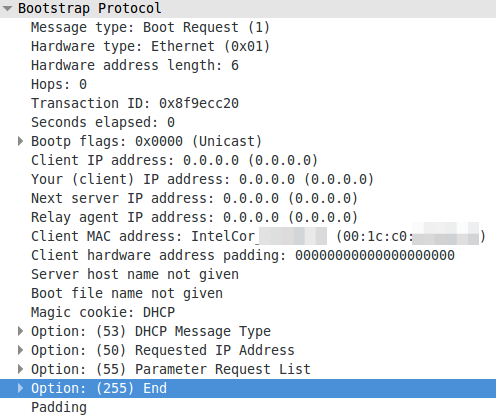
A DHCP request with a MAC address as client identifier:
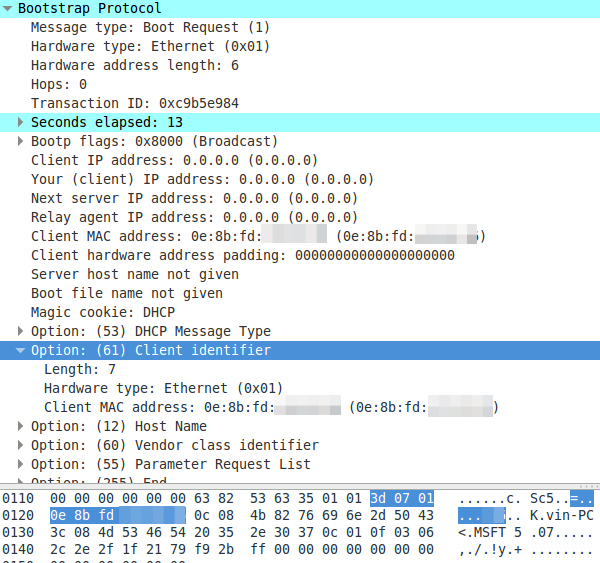
A DHCP request with a non MAC address as client identifier:
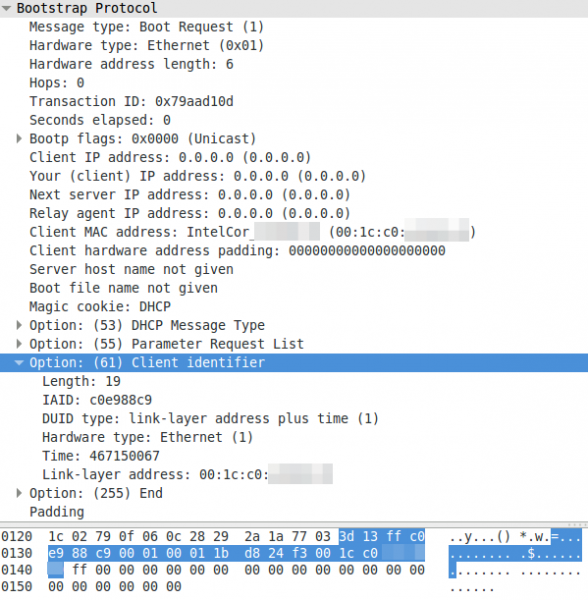
To summaries it – devices can use the MAC address or an UID to identify with the DHCP server. The problem now is that the Microsoft DHCP server does not log the MAC address anywhere and you won’t find the UID in your network logs. But as you see all requests have the client MAC address in the packet – Microsoft just does not write it into the log.
Whats funny is that the column in the Windows DHCP server log is called “MAC Address” but there is sometimes no mac address. A discussion with the Microsoft Premier Support reviled that this is a indented feature and no bug. 😉
The insecurity of the online version of the Tiroler Tageszeitung
January 17, 2015
This is the first post in over a month, why? As always I was at the Chaos Communication Congress in Hamburg and as I came back there was finally snow –> so I went ski mountaineering. Anyway here is new post, as today its raining so let’s write a post. 😉
This post is about the lack of security awareness at the major tyrolian news paper Tiroler Tageszeitung (in short TT). So lets start why I believe that is true. To be more accurate what I found within 5minutes of looking – it took much longer to write this post.
The subscriber area
When you access http://user.tt.com/ you get following Login prompt.
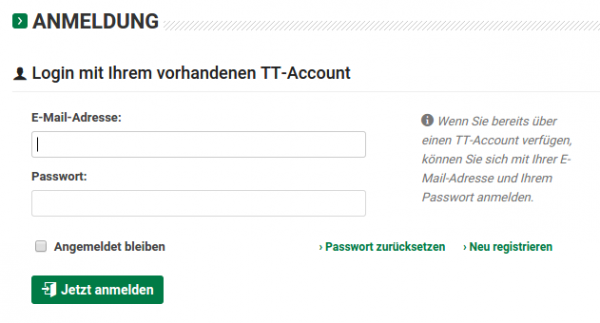
But look above ….

Yes, this site is not HTTPS protected. This is generally not a good idea as an attacker is able to change the URL the passwords are sent to after pressing the login button. But Ok, in 2011 that was not that bad, bad but not that bad. Why I talk about 2011 I’ll tell you later.
So lets enter our mail address and password and click the login button. What request is send?

Yeap!
- It is HTTP and not HTTPS? In 2014 using HTTP for login? That was even in 2011 bad.
- They are using HTTP GET with the password as parameter. I can’t believe it. Why? GET parameters are logged on web servers and even worse on proxy servers. Newer, Newer summit passwords with GET, use POST and use HTTPS!
So reading the online TT while waiting for something in a public WiFi network (which is most likely unencrypted) is not a good idea. How many TT users are reusing their password (the email address is a given) ? How may users a potentially affected?
At least I’m able to answer the second question. There is the Österreichische Auflagenkontrolle (ÖAK) … which counts how many copies of a given print media are sold.
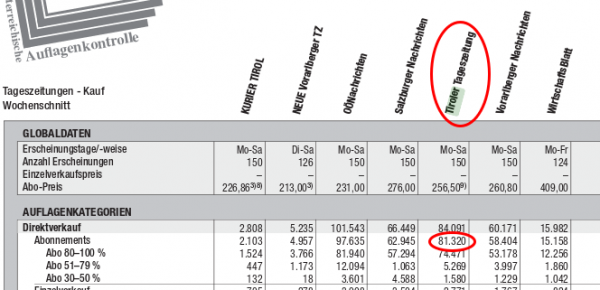
Thats from 2012, the ones from 2013 are sightly smaller but not that formated that nicely for showing a screenshot here. So over 80.000 affected users. The state of Tirol has about 720.038 citizens according to Wikipedia. So over 10% of the population is affected.
The server side
While looking at the get request I found something else interesting. At least the user.tt.com server seems to be running Debian Lenny.
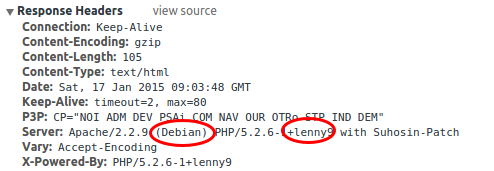
Why is that important? Let’s go to the Debian Wiki and have a look.
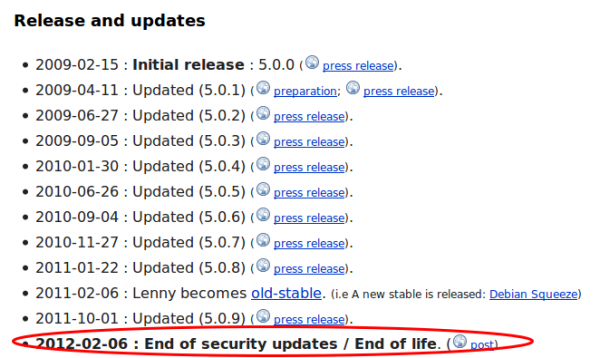
Yes, you read that correctly. No security updates since 2012 and it I believe nobody installs a system with a operation system that is old-stable, the server install and setup must be at least be from 2010. So lets take a look what vulnerabilities be could possible find for Apache 2.2 and PHP 5.2.6 patched the last time in 2012. Let’s have a look at PHP first and followed by Apache. Apache is better than PHP, but for PHP there are some pretty high rated vulnerabilities, one even with the highest rating. Basically you can get everything from the box if you want. When I took a look which JavaScript made the HTTP GET request with the password I found following.
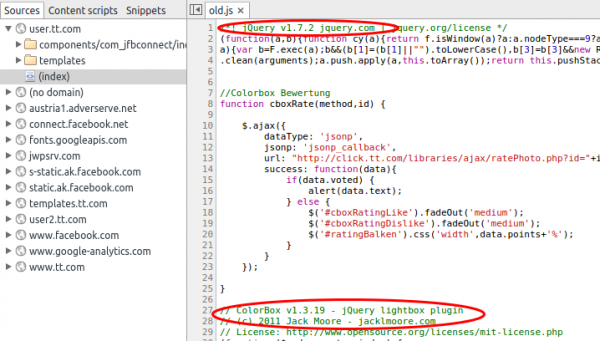
jQuery 1.7.2 that sounds old …. a look at the release notes tells 21.3.2012, not new but only a medium vulnerability … attacking PHP is easier.
Basically we could own the user.tt.com server easily, but whats about the other servers. Are they better? What is obvious from the start that the servers for the main site are different ones and they are using Varnish as is an HTTP accelerator and the learned to hight the Apache version in the HTTP header.
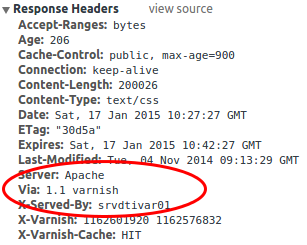
A short look in the Whois shows that the user.tt.com seems to be hosted by the TT itself and the frontend server for www.tt.com by the APA guys. It seems that they are filtering the bad stuff from the backend TT servers. As I didn’t want to dig deeper than whas possible in 5 minutes I stopped here … Just one thing I found which is not security related: tt.com is heavy using Google services for example Google Analytics.

The option _anonymizeIp() is missing here to not violate the Austrian data protections law and you need to post a information for your visitors (could not find one on tt.com) and make a opt-out possible.
So much for my 5 minutes analytics of the Tiroler Tageszeitungs homepage. 😉
Howto intercept the traffic of nearby smart phones or why you should disable WiFi in the public
December 8, 2014
This blog post will show you how easy it is to intercept the traffic of nearby smart phones, and there are no special tricks or know how needed. So lets start with a little background info:
Background
All major smart phone operating systems (e.g. Android, iOS) are keeping a list of WiFi networks you’ve be connected to and if WiFi is enabled on the phone and it sees the same SSID it will try to connect to it automatically. iOS also synchronizes the list of once connected SSIDs between your devices (iPhones, iPad and even a Mac) – so your list got a lot longer. For your encrypted home or company network this is an good idea, but this happens also for public hotspots which are unencrypted. It is possible (at least on Android) to configure the phone that it does not auto connect to a given SSID, but 95% of the user will not ever seen this option or use it.
For those that still think that hiding the SSID is a good idea, think again. It makes this attack even easier as following happens:
When you hide your wireless SSID on the router side of things, what actually happens behind the scenes is that your laptop or mobile device is going to start pinging over the air to try and find your router—no matter where you are. So you’re sitting there at the neighborhood coffee shop, and your laptop or iPhone is telling anybody with a network scanner that you’ve got a hidden network at your house or job.
SSIDs for the attack
After reading the background part, the attack vector should be obvious. We need to broadcast SSIDs the phones will automatically connect to. So what would be good SSIDs for this? There are some global ones like SSIDs from big hotel and fast food chains, than there are the ones that are big in a given nation like public transportation or telecommunication provider SSID. And at last there a big local players in the location the attack takes place. So how to get this SSIDs? Really simple, there are sites which help you finding them:
- e.g. following site which allows a search by chains and tells me e.g that the SSID for Starbucks is “WIFLY”
- or following site allows to search for airports and other bigger locations in a country. e.g. SSIDs for the Vienna airport is “Wireless Vienna Airport”
- and there are many more sites like this
but for some SSIDs you don’t need to look in the Internet, just check you’re phone and look around you.
- e.g. many who travelled with the RailJet train will have an “OEBB” SSID on their phones. And whats about the rail stations?
- Check the free WiFi SSID of your city e.g. in Innsbruck “Innsbruck Wireless“
So it should really easy to compile a list.
Hardware and Software for the attack
As we need multiple SSIDs broadcast-ed we need a hardware which allows us that and as we like it to be mobile a small embedded system like a Raspberry Pi would be nice. We also need a USB WiFi – one WiFi chip vendor which is often used for this is Atheros. And a USB UMTS/LTE stick for the up-link so we see some traffic going over our system. As software hostapd for the WiFi part and as a small DHCP/DNS server dnsmasq is commonly used. There are multiple programs to intercept the traffic which is routed over this system. I’ll not go into details on how to configure it all together so that it hopefully keeps script kiddies away.
Defence against the attack
There are several methods to minimize the attack surface, which I recommend all you use:
- The first and with the biggest benefit is to disable WiFi if not at home or work. Doing this manually won’t work (at least not for me) so I use llama on Android to enable WiFi if the GSM cell tells me I’m near my home. So I’m only vulnerable to if I’m near to my home or if I enable WiFi while travelling abroad and want to use a WiFi.
- Periodically remove SSIDs from your phone you don’t need any more. On Android this can be done on the phone. On iOS you can delete the SSIDs on your Mac which gets synchronized to your phone. Adding unencrypted SSIDs is a one click operation you I’ll recommend to remove all unencrypted ones.
- Make sure all traffic (like pop3, imap, smtp, xmpp, …) is encrypted and make sure it’s not “encrypt if possible” (why? take a look at that post) , you’ll never know when your phone roams into an insecure network. Even if the WiFi is not provided by the attacker, hotspots are normally not encrypted!
Outlook
With the same method it is also possible to attack the phone directly. Why is that important? Many providers assign only 10.x.x.x IP addresses to the phones and use “Carrier Grade NAT” (CGN) to translate that to “real” IP addresses. They mostly do this because of the amount of IPv4 addresses they would need otherwise, but it also does not allow connecting directly to the phones. And a targeted attack is much easier if you see the MAC address of the device and in this case you even don’t need an up-link. 🙂
Filter traffic from and to Tor IP addresses automatically with Mikrotik RouterOS
November 30, 2014
Some newer malware communicates with their command and control servers via the Tor network, in a typical enterprise network no system should connect the Tor network. A other scenario is that you’re providing services which don’t need to be accessed via the Tor network but your servers get attacked from Tor Exit Nodes. In both cases it may be a good defence to filter/log/redirect the traffic on your router. With Mikrotiks RouterOS this is possible. You need also a small Linux/Unix server to help. This server needs to be trustworthy one as the router executes a script this server generates. This is required as RouterOS is only able to parse text files up to 4096 by itself, and the Tor IP address list is longer.
Linux Part
So first we create the script /usr/local/sbin/generateAddTorIPsScript.sh on the Linux server with following content:
#!/bin/sh
# the full path of the file we create
filename=/var/www/html/addTorIPs.rsc
# remove the comment if you want to use the List of All Current Tor Server IP Addresses
#url=http://torstatus.blutmagie.de/ip_list_all.php/Tor_ip_list_ALL.csv
# remove the comment if you want to use the List of All Current Tor Server Exit Node IP Addresses
#url=http://torstatus.blutmagie.de/ip_list_exit.php/Tor_ip_list_EXIT.csv
echo "# This scrip adds Tor IP addresses to an address-list (list created: $(date))" > $filename
echo "/ip firewall address-list" >> $filename
/usr/bin/wget -q -O - $url | sort -u | /bin/awk --posix '/^[0-9]{1,3}\.[0-9]{1,3}\.[0-9]{1,3}\.[0-9]{1,3}/ { print "add list=addressListTor dynamic=yes address="$1" " ;}' >> $filename
The filename path works on CentOS, on Ubuntu you need to remove the html directory. Now make the file executable
chmod 755 /usr/local/sbin/generateAddTorIPsScript.sh
and execute it
/usr/local/sbin/generateAddTorIPsScript.sh
No output is good. Make sure that the file is reachable via HTTP (e.g. install httpd on CentOS) from the router. If everything works make sure that the script is called once a day to update the list. e.g. place a symlink in /etc/cron.daily:
ln -s /usr/local/sbin/generateAddTorIPsScript.sh /etc/cron.daily/generateAddTorIPsScript.sh
Mikrotik part
Copy and pasted following to get the script onto the router:
/system script
add name=scriptUpdateTorIPs policy=ftp,reboot,read,write,policy,test,password,sniff,sensitive source="# Script which will download a script which adds the Tor IP addresses to an address-list\
\n# Using a script to add this is required as RouterOS can only parse 4096 byte files, and the list is longer\
\n# Written by Robert Penz <[email protected]> \
\n# Released under GPL version 3\
\n\
\n# get the \"add script\"\
\n/tool fetch url=\"http://10.xxx.xxx.xxx/addTorIPs.rsc\" mode=http\
\n:log info \"Downloaded addTorIPs.rsc\"\
\n\
\n# remove the old entries\
\n/ip firewall address-list remove [/ip firewall address-list find list=addressListTor]\
\n\
\n# import the new entries\
\n/import file-name=addTorIPs.rsc\
\n:log info \"Removed old IP addresses and added new ones\"\
\n"
To make the first try run use following command
/system script run scriptUpdateTorIPs
if you didn’t get an error
/ip firewall address-list print
should show many entries. Now you only need to run the script once a day which following command does:
/system scheduler add interval=1d name=schedulerUpdateTorIPs on-event=scriptUpdateTorIPs start-date=nov/30/2014 start-time=00:05:00
You can use this address list now in various ways .. the simplest is following
/ip firewall filter
add chain=forward comment="just the answer packets --> pass" connection-state=established
add chain=forward comment="just the answer packets --> pass" connection-state=related
add action=reject chain=forward comment="no internal system is allowed to connect to Tor IP addresses" dst-address-list=addressListTor
add chain=forward comment="everything from internal is ok --> pass" in-interface=InternalInterface
A practical example how broken MD5 really is
November 5, 2014
Nat McHugh did a wonderful post with two completely different monochrome pictures which have the same MD5 sum. Take a look! MD5 as a secure hash function should provide the properties shown in this Wikipedia article. But as Nat says in his own words:
I believe he is correct, nothing shows better how broken MD5 is than two images with the same MD5 sum and that really nobody should use it anymore for security reasons. Using it for checking file corruption during transfer is Ok, but the hash for ISO files or packages for Linux Distributions you download should not be checked with MD5. CPU power is cheap nowadays. The big ones like Ubuntu, Debian and CentOS already have changed to provide also SHA1 and SHA256 hashes for all the files. OpenSuse provides MD5 and SHA1 … better would be SHA256 too. Anyway use SHA256 were possible to verify your downloads!!


Sony Xperia smart phones have an automatically recreated “Baidu” folder and connect to a server in China
November 1, 2014
As I’m a user of a Sony Xperia smart phone I pick that thread up. In the Sony support forums a really log thread is running because all current Xperia smart phones got with the Upgrade to Android 4.4 and folder “Baidu” on the internal storage. If you delete it and reboot the phone it gets recreated. Here a screenshot from lggyjp from the forums:

Sony is claiming that this is the connection to Baidu the Chinese Google equivalent, but the setup has some potential implications which gets user upset. An example is the post by Elbrid in the forum:
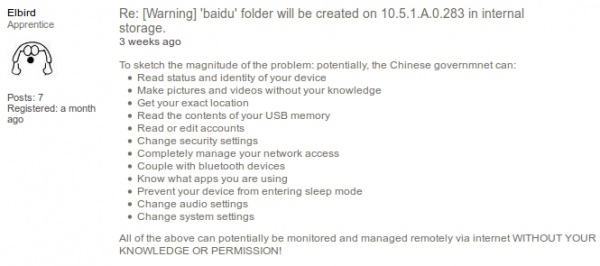
Following is the response by Sony, first by a support guy called Richard:
This folder will be removed in future software updates for the phone. Until then i can only advise that you delete it manually after a reboot if you want to remove it. It’s safe to just delete it.
and than the post yesterday by responsible manager:
Hey guys
Magnus Hilding here – I’m heading the team developing MyXperia @ Sony Mobile. As Rickard said, we built the app using both protocols to ensure both our Chinese and global users could enjoy MyXperia. However, we’ve designed later versions to package the service relevant to a specific region only – these updates are right around the corner, rolling out soon.
As Rickard said, it’s really nothing to worry about.
/Magnus
If you want to remove it at once and not wait for Sony, take a look at this article which shows the 9 steps needed to get rid of it.
Howto get an A+-Rating at Qualys SSL Labs with Apache 2.2
One of my HTTPS servers currently gets an A- on Qualys SSL Labs test, as I’m running Ubuntu 12.04 LTS with Apache 2.2 which does not support the ECHDE-Cipher suites, which is required for Perfect Forward Secrecy with the Internet Explorer.
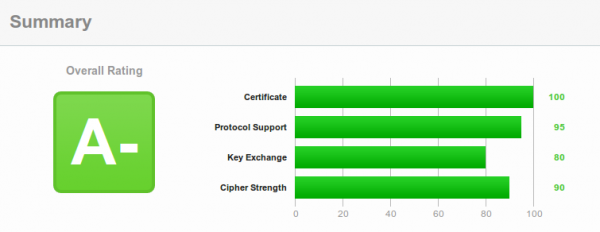
Upgrading to Ubuntu 14.04 needs some major rework for which I currently don’t have the time for.But there is now a trick to get that A-Rating and it is called TLS Interposer. It uses LD_PRELOAD to intercept the OpenSSL API calls and adds some additional features and security settings.
Currently there is no deb package for Ubuntu 12.04, so we need to compile it for our-self:
wget https://github.com/Netfuture/tlsinterposer/archive/master.zip
unzip master.zip
cd tlsinterposer-master/
make
Possible errors:
make: cc: Command not found-> install the gcc (apt-get install gcc)tlsinterposer.c:29:25: error: openssl/ssl.h: No such file or directory–> Install the OpenSSL Development package (apt-get install libssl-dev)
Now we need only an make install and we’re ready to try it. For this we add
export LD_PRELOAD=/usr/local/lib/libtlsinterposer.so
at the end of
/etc/apache2/envvars
and restart Apache with
/etc/init.d/apache2 restart
And you get
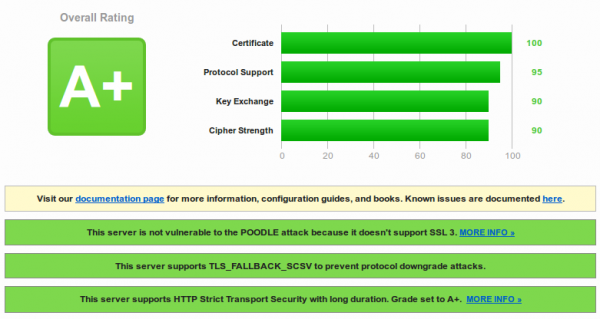
Success!!!
You need also following for an A+ Rating:
- Following needs to be still in the Apache config:
SSLProtocol ALL -SSLv2 -SSLv3
SSLHonorCipherOrder On
SSLCompression Off
# SSLCipherSuite settings will be ignored - You need to HSTS configured, check this link for how to enable it on Apache 2.2
So this is with Ubuntu 12.04 … I’ve tried the same with Centos 6 but I didn’t have success. Following problems did arise
1. Makefile
The Makefile does not support the names of the ssl libs on Centos 6 – when you compile, you get:
tlsinterposer.c:85: error: ‘DEFAULT_SSLLIB’ undeclared here (not in a function)
The Makefile has a regex that does not work with Centos 6. I changed following
# diff Makefile.orig Makefile
32c32
< ldconfig -p | sed -n -e 's/^\t*\(libssl\.so\.[0-9]\.[0-9]\.[0-9]\).*/#define DEFAULT_SSLLIB "\1"/p' > $@
---
> ldconfig -p | sed -n -e 's/^\t*\(libssl\.so\.[0-9][0-9]\).*/#define DEFAULT_SSLLIB "\1"/p' > $@
and deleted the file ssl-version.h and called make again and it compiled. I’ve reported that to author.
2. application’s cipher is not overwritten
Loading the TLS Interposer with putting it in /etc/sysconfig/httpd and than doing an /etc/init.d/httpd restart worked but the application’s cipher didn’t get changed. I could verify that with the test scripts which come with TLS Interposer:
# ./run_tests
gcc -O2 -Wall -Wextra simple_server.c -lcrypto -lssl -o simple_server
Test 1a pass
Test 1b FAIL!
Test 1c pass
Test 1d pass
Test 1e pass
Test 2a pass
Test 2b pass
Test 2c pass
Test 3a pass
Test 3b pass
Test 4a pass
Test 4b pass
Test 4c pass
Test 5a pass
Test 5b pass
Test 5c pass
Test 5d pass
I’ve reported that to the author. If I get an update on this I’ll report in my blog about this.
Take care if using Ubuntu 12.04 as a client – TLS 1.2 is not enabled by default
October 24, 2014
It got fixed with Ubuntu 14.04 but 12.04 is still supported and many people are still using 12.04 and even with the OpenSSL package update (2014-10-02) TLS 1.2 is not enabled by default. Take a look at this bug report and the statement from Marc Deslauriers (Ubuntu Security Engineer):
That USN doesn’t re-enable TLSv1.2 by default for clients in Ubuntu 12.04. It simply fixes an issue if someone _forced_ TLSv1.2 to be enabled.
You’re asking why we got into that problem in the first place … Marc tells us also this:
Ubuntu 12.04 contains openssl 1.0.1, which supports TLS v1.2. Unfortunately, because of the large number of sites which incorrectly handled TLS v1.2 negotiation, we had to disable TLS v1.2 on the client.
So someone thought again he is smarter than the OpenSSL guys … but this was not the first time …. lets remember this “optimization” of OpenSSL by the Debian guys .. could they please clean up their mess and enable TLS 1.2 by default as in 14.04?
Powered by WordPress
Entries and comments feeds.
Valid XHTML and CSS.
44 queries. 0.086 seconds.





